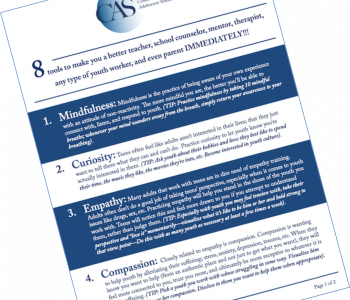

Catharine Hannay, MA
Catharine Hannay is the founder of MindfulTeachers.org and the author of Being You: A Girl’s Guide to Mindfulness, a workbook for teen girls on mindfulness, compassion, and self-acceptance.
The Enneagram: A Powerful Tool for Personal and Professional Growth
Do you tend to make a mountain out of a molehill? Or do you tend to have one of these reactions?
1: You must not make a mountain out of a molehill. That’s the rule.
2: Let me help you see that the mountain is really a molehill. While we’re at it, what else do you need me to do for you?
3: I’ve just finished creating a perfectly round molehill. Now I immediately need to start turning it into a mountain, and I need to do it perfectly.
4: Nobody understands what it’s like for me to make a mountain out of a molehill.
5: I shall examine the mountain thoroughly in order to determine whether it is really a molehill.
6: You can always count on me to make a mountain out of a molehill! (And I mean this in both senses: I’m very dependable and reliable, and I worry about everything.)
7: Look, a molehill! (Jumps on and off the molehill a few times.) That was fun, but now I’m bored. Oooh, let’s trap a mole and keep it as a pet! Then I can create a video series about my pet mole. Hey, let’s go mountain climbing!
8: OK, troops, we’ve climbed the molehill. Now I’m going to lead you to the top of the mountain, and we’re gonna make it, no matter what!
9: Sure, we can make a mountain out of a molehill if that’s what you want to do. (Sigh.) No, really, I don’t mind at all. (It’s not like anybody cares about my opinion, anyway.)
Can you see yourself in any of these statements? How about your family, your friends, and the youth you serve in your work?
If you’re familiar with the Enneagram system, you probably recognized each of those statements as a whimsical description of one of the nine personality types. I’m a type 6, and I definitely tend to make a mountain out of a molehill. Heck, I can make a mountain out of an anthill!
The word “Enneagram” comes from the Greek words ennea (nine) and grammos (figure); this “nine-pointed figure” shows the ways the different types are connected. We each have one dominant type and also exhibit characteristics from a few different types.
There’s quite a lot of in-depth information at enneagraminstitute.com if you’re interested in exploring this further. For our purposes today, I’ll keep it simple and just focus on brief descriptions of the nine basic types.
- Ones are: “Ethical and conscientious, with a strong sense of right and wrong. […] They try to maintain high standards but can slip into being critical and perfectionistic.”
- Twos are: “Driven to be close to others, and often do things for others in order to be needed. They typically have problems taking care of themselves and acknowledging their own needs.”
- Threes are: “Ambitious, competent, and energetic, they can also be status-conscious and highly driven by personal advancement. […] They typically have problems with workaholism and competitiveness.”
- Fours are: “Self-aware, sensitive, reserved, and quiet. […] They can also be moody and self-conscious. […] They typically have problems with self-indulgence and self-pity.”
- Fives are: “Alert, insightful, and curious. They are able to concentrate and focus on developing complex ideas and skills. […] They can become preoccupied with their thoughts and imaginary constructs.”
- Sixes are: “Reliable, hard-working, and responsible, but they can also be defensive, evasive, and highly anxious. […] They typically have problems with self-doubt and suspicion.”
- Sevens: are: “Playful, high-spirited, and practical, they can also be overextended, scattered, and undisciplined. They constantly seek new and exciting experiences, but they can become distracted and exhausted by staying on the go.”
- Eights are: “Self-confident, strong, and assertive. Protective, resourceful, and decisive, they can also be proud and domineering.”
- Nines are: “Good-natured, kind-hearted, easy-going, and supportive but can also be too willing to go along with others to keep the peace […] They typically have problems with passivity and stubbornness.”
(excerpts from The Wisdom of the Enneagram, Don Richard Ruso and Russ Hudson)
As you can see even from these very brief descriptions, each type has both advantages and disadvantages. The point isn’t just to label ourselves (and certainly not to go around labeling other people), but to gain a deeper understanding of our emotional and interpersonal challenges.
“In relating to others, it is important to keep in mind the distinction between what we are comfortable with (what comes ‘naturally’) and what is likely to be effective in the situation. […] To be effective in dealing with others, we need to keep their point of view and way of dealing with life in mind. To simply act out of our ‘comfort zone’ may be natural for us. But it may not achieve the effect we intend with someone else.”
(Dick Wright The Enneagram Triads: A Key to Personal and Professional Growth, p. 98)
Why We Need All the Types
Il faut de tout pour faire un monde.
It takes all sorts to make a world.
–French proverb
In their book What’s Your Enneatype? Josh Carver and Liz Green imagine what the world would be like if it were made up of only one type of people.
- A World of ONEs: “The world would be filled with hardworking, exhausted, well-meaning perfectionists.” (p. 28)
- A World of TWOs: “Everyone would compete to out-love one another, never taking care of themselves.” (p. 42)
- A World of THREEs: “The world would be organized, efficient, and productive. […] People would choose productivity over emotional health, over each other, and over the greater good.” (p. 59)
- A World of FOURs: “There would be great potential for people to be more connected but also great potential for tormented separation and loneliness as people competed for uniqueness.” (p. 75)
- A World of FIVEs: “The world would be quieter—much quieter. […] While everyone would have studied how to get things done, no one would actually get anything done, so the world would be full of great ideas with zero execution.” (p. 90)
- A World of SIXES: “At their best, people would be responsible, welcoming, and peaceful, protecting each other and watching out for each other. […] However, at their worst, people would be anxious, fearful, overprotective, and worried. They would be too concerned with the future to act on it.” (p. 105)
- A World of SEVENs: “The world would be like an unstructured playground, full of possibilities and exclamation points! […] Life would be frenzied and exhausting.” (p. 123)
- A World of EIGHTs: “The world would be much more intense […] with everyone playing the role of queen bee, and nobody would trust anybody’s authority enough to let themselves be the worker bee.” (p. 137)
- A World of NINEs: “The world would be agreeable and peaceful on the surface. However, under the surface, everyone would be boiling with passive-aggression […] and nothing would ever get done because no one could decide what to do.” (p. 153)
Questions to Promote Self-Awareness and Self-Care
Kacie Berghoef and Melanie Bell suggest reflecting on the following questions to “interrupt your type’s usual way of seeing and engaging with the world […] in order to give you new ways of looking at things and open up possibilities.”
Whether or not you’ve already identified your type, you might want to consider all of these questions. Which of them are easiest for you to answer? Which are the most challenging? Which of the questions do you most resist?
Type 1: “What do I want to do that’s fun, and how can I make it happen?”
Type 2: “How can I show care for myself the way I do for my loved ones?”
Type 3: “What would I do with my time if no one was watching me?”
Type 4: “What are the realistic desires behind my fantasies, and what steps can I take to make them come true?”
Type 5: “Do I actually need to know more about this, or can I get started and learn as I go along?”
Type 6: “What would I do if I weren’t afraid, and how can I do it anyway?”
Type 7: “Which of my ideas is worth focusing on?”
Type 8: “What support do I need from others, and how can I receive it?”
Type 9: “Is this a situation where I’m truly fine with any outcome, or do I have an opinion?”
(The Modern Enneagram: Discover Who You Are and Who You Can Be, p. 157-160)
Conclusion
I hope this very brief introduction to the Enneagram has been useful in thinking through your own emotional and interpersonal strengths and challenges. In a future post here at the Center for Adolescent Studies, Dr. Sam Himelstein will explain how he uses the Enneagram with his teen clients.
If you’re interested in learning more about the Enneagram as a tool for personal development, I recommend the following resources.
Recommended Books about the Enneagram:
- The Path Between Us: An Enneagram Journey to Healthy Relationships by Suzanne Stabile
- What’s Your Enneatype? an Essential Guide to the Enneagram by Liz Carver and Josh Green
- The Wisdom of the Enneagram: The Complete Guide to Psychological and Spiritual Growth for the Nine Personality Types by Don Richard Riso and Russ Hudson
Recommended Websites about the Enneagram:
- ninepaths.com, especially the ‘fatal flaws’ of each type and the ‘type comics’
- enneagraminstitute.com, especially the detailed type descriptions
If you like this post, you might also be interested in the following posts about self-awareness and self-care for helping professionals:

